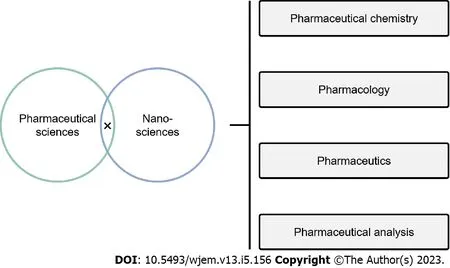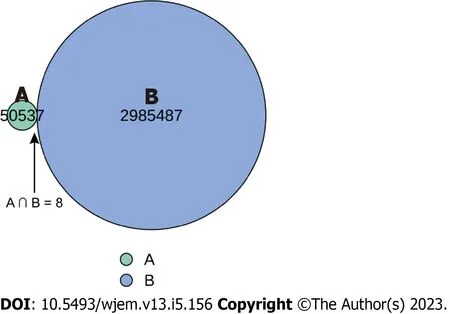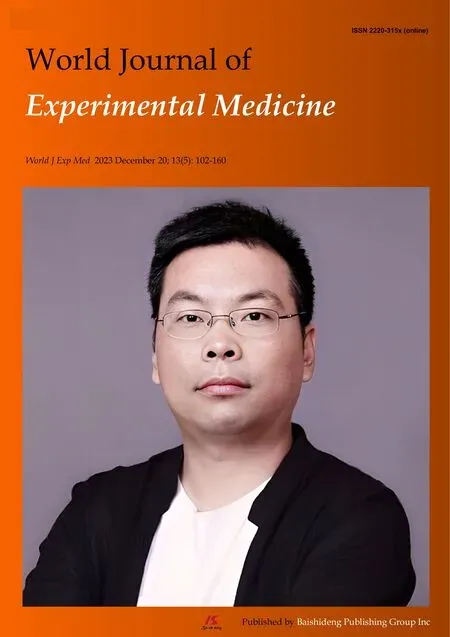Research on nanosciences involvement in pharmaceutical education should be reinforced
2023-12-22ZhengWeiHuangYeQiHuang
Zheng-Wei Huang,Ye-Qi Huang
Abstract Inclusion of nanoscience in pharmaceutical education should be reinforced, in order to match the demand of current pharmaceutical talent cultivation.
Key Words: Nanosciences; Pharmaceutical education; Talent cultivation; Reformation
TO THE EDlTOR
Since the 1990s, nanoscience has gained rapid momentum in research and development. Although nanotoxicology is a rising concern worldwide[1], and the ethical issues (so-called “nanoethics”)[2] and the ecological risks[3] of nanotechnology have been identified, the application of nanomaterials and nanotechnologies is still a focus.
Consequently, various nanomaterials and nanotechnologies have been developed and introduced into different fields, including the chemical, biological, environmental, medical, and pharmaceutical sciences. In the chemistry field, it is possible to apply nanotechnologies to various chemical compounds, including polymers, to modify their structure and function. In a recent study, metal-organic framework based nano-adsorbents have made a number of noteworthy advances in anti-chemical warfare reagents[4]. In the biology field, one of the most acclaimed achievements in nanotechnology in molecular biology is identification of the vaccination mechanism for coronavirus disease 2019 (COVID-19) using nanoscale vector systems[5]. In the environment field, nanotechnology is utilized not only to enhance the environment but also to produce renewable sources of energy. A paradigmatic example is the employment of nanofluids in solar cells which can produce electricity at a competitive cost[6]. In the medical field, the successful application of nanomedicine has helped to develop enhanced versions of diagnostics, treatment, prevention, and proactive healthcare measures[7]. Recent research has shown that the controllability of nanorobots has advanced, allowing for efficient remodeling of dense tumor stromal microenvironments to enable deep tumor penetration[8].
As pharmaceutical researchers, the authors of this paper consider that nanoscience is deeply involved in the field of pharmaceutical sciences. The following are several key examples: (1) Pharmaceutical chemistry: one-component new chemical entity nanomedicines are synthesized to enhance therapeutic efficacy[9]; (2) Pharmacology: nanovesicles can be used as analytical tools to investigate cellular signaling pathways[10]; (3) Pharmaceutics: nanoparticles are effective carriers for drug loading and delivery[11]; (4) Pharmaceutical analysis: nanotechnologies can facilitate the separation, identification, and quantification of drug molecules[12]. This information is schematically illustrated in Figure 1.

Figure 1 Main applications of nanoscience and nanotechnology in pharmaceutical sciences.
As nanoscience has become an ever more integral part in pharmaceutical sciences, individuals with pharmaceutical interests (i.e., pharmaceutical scientists, pharmacists, staff in the pharmaceutical industry, and governors in drug administration) should master the relevant knowledge and skills regarding nanoscience. Pharmaceutical education is the fundamental and vital approach for cultivating pharmaceutical talent; hence, pharmaceutical curricula should involve imparting knowledge and skills on nanoscience. However, for several pharmaceutical education systems worldwide, the core courses in pharmaceutical curricula remain focused on the subdisciplines of pharmaceutical sciences (such as pharmaceutical chemistry, pharmacology, pharmaceutics, and pharmaceutical analysis[13] and fundamental chemistry (such as inorganic, organic, and physical chemistry and biochemistry[14], and courses focused on nanoscience are insufficient or even absent. The reasons for this may include the following: Nanotechnology is a cutting-edge research field; its novelty may present some challenges to the faculty. Even in a nanoscience or nanotechnology training program, some teachers show a preference for teaching more familiar courses so that they can apply the knowledge into the classroom in a timely manner[15]. It is documented that low self-confidence, associated with a lack of knowledge on the new content, sometimes hinders the acceptance and the willingness to use it in the classroom[16]. Another aspect is that the study of basic theoretical subjects is still generally considered necessary in pharmacy education. Some people therefore reject the educational importance of nanoscience, believing that there is no room for a new science curriculum like that[17].
Moreover, not only are current courses lacking in coverage of nanoscience, retrospective/progressive/prospective studies on the inclusion of nanoscience in pharmaceutical education are also in their infancy. The authors consulted six databases associated with Web of Science (Web of Science Core Collection, Chinese Science Citation Database, KCIKorean Journal Database, Medline, ProQuest Dissertations & Theses Citation Index, and SciELO Citation Index) using various search sets (Table 1) on July 13, 2023. Documents published between 1965 and 2023 were searched, and all document types and languages were included. Duplicate and irrelevant publications were manually excluded. However, according to the results of the literature survey, only eight documents were retrieved, which was surprisingly low. For comparison, the number of documents on pharmaceutical education and nanoscience were 50537 and 2985487, respectively. These results are shown in a Venn diagram in Figure 2. From the authors’ perspective, characterized by interdisciplinarity, nanoscience is a deeply interconnected discipline, encompassing diverse areas of modern science and technology. When taking nanoscience into the classroom, it has been confronted with the dilemma of whether it should be taught as a new or a subsidiary discipline. Accordingly, the intricate nature of nanoscience may be the possible reason that has resulted in a scarcity of research exploring its intersection with a specialized field such as pharmacy education.

Figure 2 Euler Venn diagram showing the intersection of the publications on pharmaceutical education (A) and nanoscience (B).

Table 1 Search sets for literature retrieval
Overall, the current scenario is that insufficient attention has been paid to the inclusion of nanoscience into pharmaceutical education. Consequently, the cultivation of pharmaceutical talents mastering the required knowledge and skills of nanoscience cannot be guaranteed. With the continuous development of nanoscience, its inclusion in pharmaceutical science will become more comprehensive in the future. It is worth noting that the market for nanomedicines for disease management has great potential. The global market for nanomedicine was estimated at $53 billion in 2009. It is expected to grow by 13.5% to reach $100 billion in recent years[18]. These data demonstrate global interest in the nanoscience field. Therapeutic formulations utilizing nanotechnology hold potential for improving clinical outcome. Engineered nanomaterials are rapidly evolving in drug development, and offer promise in overcoming biological barriers and achieving precise drug delivery for precision medicine[19]. In addition, the potential of nanotechnology in pharmacy will be further expanded with efforts to combine nanomaterials with some established formulations. Recent studies have pointed out that the combined properties of hydrogels and nanoparticles in smart nanogels can improve drug loading capacity, drug stability, target delivery and therapeutic efficacy[20]. Considering these factors, it is foreseeable that nanotechnology will become more widely and tightly integrated into pharmaceuticals in the future. Thus, correspondingly, continued efforts are required to promote the inclusion of nanoscience in pharmaceutical education.
To achieve this aim, the authors propose three suggestions:
Firstly, colleges and universities should establish scientific foundations for the educational reformation of nanoscience courses; the role of foundations in support of the education process is essential. A positive example to be studied is the National Science Foundation (NSF). The NSF is charged with funding basic research programs to maximize the advancement of science in the United States through the development of scientific information. In the National Nanotech-nology Initiative, NSF assumed responsibility for funding basic research and education in nanoscience and nanotechnology, leading to a healthy growth of nanotechnology in the United States[21]. Referring to the operation and supporting model of NSF, sufficient attention from colleges and universities should be given to the investment of adequate funding to meet the development of nanoscience in pharmacy education.
Secondly, faculties must initiate changes to their curricular systems and add nanoscience courses. In the post-pandemic era, the rate of change in healthcare has rapidly accelerated. Consequently, healthcare professionals must dedicate themselves to lifelong learning through continuing education and professional development programs, including those associated with nanoscience[22]. For instance, teachers should learn about the applications of nanotechnology in COVID-19 treatment, and pass this knowledge to the students in the classroom. Through these efforts, students can gain scientific and technological literacy, which has a significant impact on curriculum design[15]. It can also serve as an effective means of bridging the gap between workforce needs and cutting-edge fields[23].
Lastly, journals, such as theWorld Journal of Experimental Medicine, should encourage the submission of relevant studies as a publishing platform. Currently, the evaluation of papers by impact factor is still the dominant approach used by journals. However, this single-factor approach has led to much discussion about its update or revolution[24], and the actual implication of papers for the real world should be reconsidered. As a publishing platform, considering and encouraging papers based on multiple factors may be a positive guide for the conduct of research focusing on a rare field (the very scenario of nanoscience education in pharmacy). The authors envision that the degree of inclusion of nanoscience in pharmaceutical education can be increased in the near future.
In summary, nanoscience is rapidly evolving in a number of disciplines and fields. It has been widely used in the fields of chemistry, biology, environment, medicine, and pharmacy, and has attracted much attention. Especially in the field of pharmacy, nanoscience and nanotechnology have played a significant role. However, at present, the coverage of nanoscience in pharmaceutical courses and educational studies is lacking, which is detrimental to the cultivation of talents in this field. The gaps in this area should be further addressed by all groups. We propose three suggestions to boost the inclusion of nanoscience in pharmacy education: (1) Colleges and universities should establish scientific foundations for the educational reformation of nanoscience courses; (2) faculties must initiate changes to their curricular systems and add nanoscience courses; and (3) journals should encourage the submission of relevant studies as a publishing platform. Similar to the situation in pharmacy education, clinical medicine training should also include more courses on nanotechnology, and we will be conducting in-depth research on this topic in the future.
FOOTNOTES
Author contributions:Huang Z designed the study and wrote the letter; Huang Y polished the language and prepared the artwork.
Supported byNational Natural Science Foundation of China, No. 82104070.
Conflict-of-interest statement:All the authors declare that they have no conflict of interest.
Open-Access:This article is an open-access article that was selected by an in-house editor and fully peer-reviewed by external reviewers. It is distributed in accordance with the Creative Commons Attribution NonCommercial (CC BY-NC 4.0) license, which permits others to distribute, remix, adapt, build upon this work non-commercially, and license their derivative works on different terms, provided the original work is properly cited and the use is non-commercial. See: https://creativecommons.org/Licenses/by-nc/4.0/
Country/Territory of origin:China
ORClD number:Zheng-Wei Huang 0000-0003-2351-7347.
S-Editor:Liu JH
L-Editor:Webster JR
P-Editor:Yuan YY
杂志排行
World Journal of Experimental Medicine的其它文章
- Exploring the mechanism of action bitter melon in the treatment of breast cancer by network pharmacology
- In vitro study on the transmission of multidrug-resistant bacteria from textiles to pig skin
- Ground level utility of Access, Watch, Reserve classification: lnsights from a tertiary care center in North lndia
- Red cell distribution width: A predictor of the severity of hypertriglyceridemia-induced acute pancreatitis
- Altered expression of miR-125a and dysregulated cytokines in systemic lupus erythematosus: Unveiling diagnostic and prognostic markers
